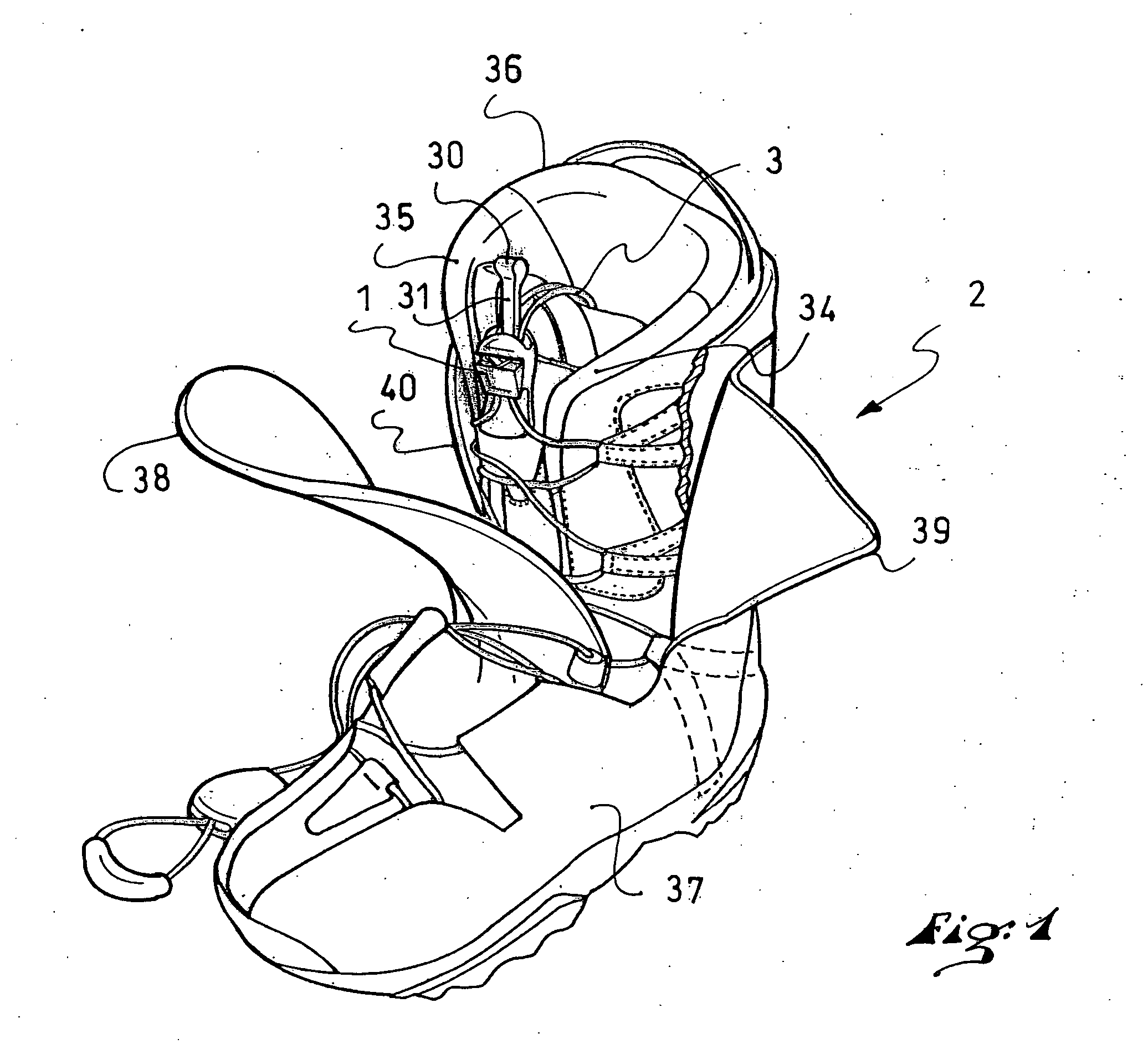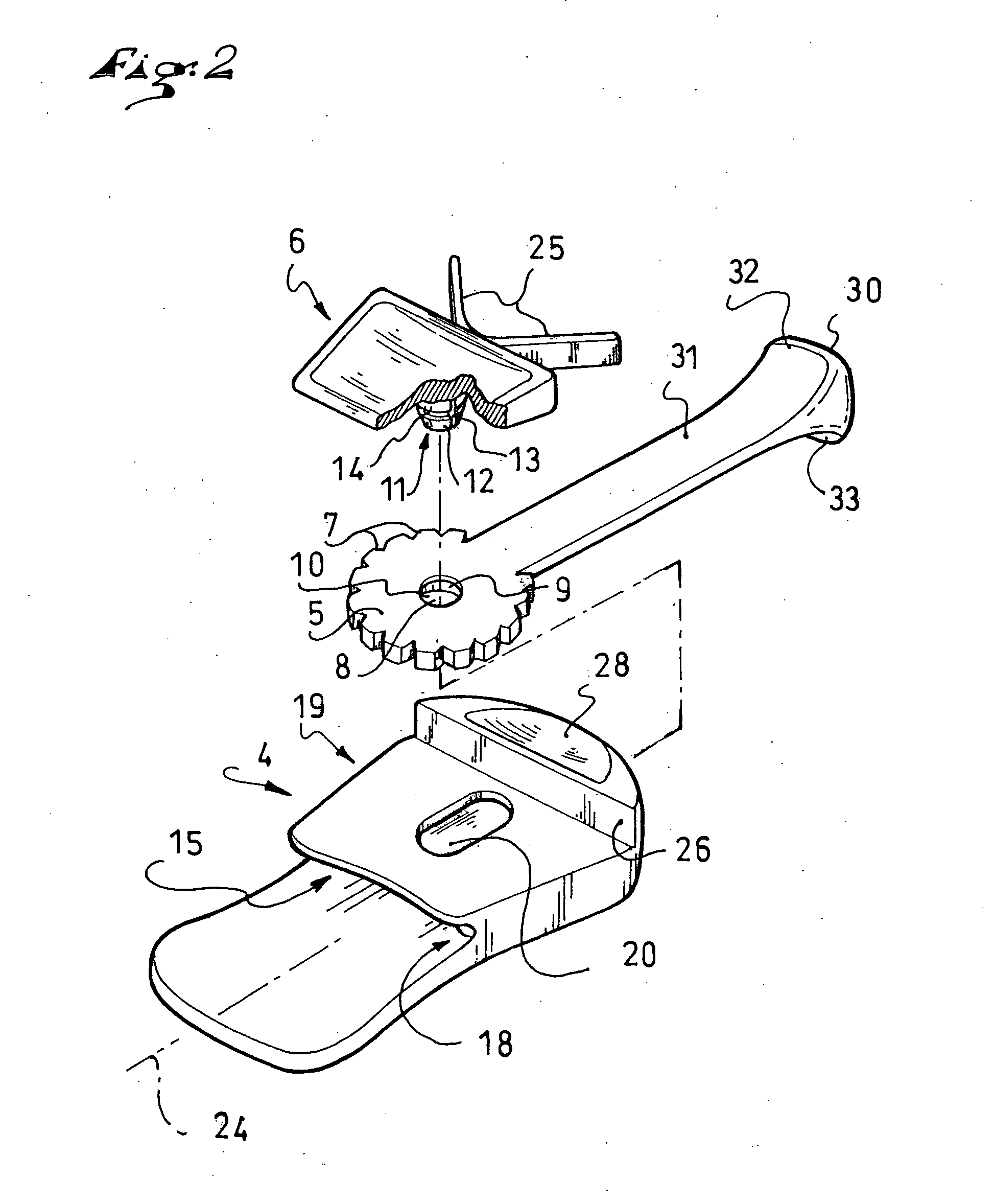Lace blocking device
a technology of lace and lace, which is applied in the direction of textile cables, ropes and cables for vehicles/pulleys, applications, etc., can solve the problems of difficult unblocking operation, difficult unblocking operation, and difficult unblocking operation, so as to achieve greater unblocking facility and easy grasping and manipulation
- Summary
- Abstract
- Description
- Claims
- Application Information
AI Technical Summary
Benefits of technology
Problems solved by technology
Method used
Image
Examples
first embodiment
[0034] A first embodiment according to the invention will be described with reference to FIGS. 1-8.
[0035] A lace blocker 1 is shown in FIG. 1 for blocking a lace 3 for an application to a snowboard boot 2.
[0036] As shown more particularly in FIG. 2, the blocker 1, or blocking device, includes three elements, namely, a body 4, a blocking member 5 having a circular shape, and a cursor 6 located outside of the body 4 and connected to the blocking member 5 in order to manipulate it. The cursor can also be referred to as a slider or a pusher member.
[0037] In the detail shown in the drawings, the blocking member 5 can take the form of a wheel provided with teeth 7 on its periphery.
[0038] Through the center of the blocking member 5, or wheel, is a hole 8 which, in the illustrated example, is lined with a facing 9 to define an eyelet 10 for receiving an axle 11 of the cursor 6 in a force-fit, or snap fitting used in ratchets, which then provides the rotational axis of the wheel of the bl...
second embodiment
[0078] The second embodiment is shown in FIG. 9.
[0079] According to this embodiment, a blocker 50 has a hollow body 51, a blocking member shown in the form of a wheel 52, and a cursor 53. These elements are assembled to function in a manner similar to the blocker of the first embodiment.
[0080] According to the invention, an unblocking member has a gripping portion located at a distance from the hollow body 51.
[0081] The gripping portion is shown in the form of a grip 60 that is connected to a handle 61. In this manner, the unblocking member includes the grip 60 and the handle 61.
[0082] A connecting end of the handle 61, opposite the end receiving the grip, has a through hole 62. In this manner, the handle 61 and the wheel 52 are rotationally mounted on the same axle 63 originating from the cursor 53. Consequently, a traction on the grip 60 in a spacing direction with respect to the hollow body 51 biases the wheel 52 in an unblocking direction. Here again, the bias is direct, sinc...
third embodiment
[0083] the invention is shown in FIG. 10.
[0084] According to this example, a blocker has a wheel 70.
[0085] According to the invention, an unblocking member has a gripping portion located at a distance from the hollow body.
[0086] The gripping portion has a grip 80 that is connected to a handle 81. Here again, the unblocking member includes the grip 80 and the handle 81. The wheel 70, the grip 80 and the handle 81 form a unitary element.
[0087] In the third embodiment, the grip 80 includes an opening 82. This opening can be sufficiently large for the passage of a finger, allowing for a gripping with a bent finger.
PUM
 Login to View More
Login to View More Abstract
Description
Claims
Application Information
 Login to View More
Login to View More - R&D
- Intellectual Property
- Life Sciences
- Materials
- Tech Scout
- Unparalleled Data Quality
- Higher Quality Content
- 60% Fewer Hallucinations
Browse by: Latest US Patents, China's latest patents, Technical Efficacy Thesaurus, Application Domain, Technology Topic, Popular Technical Reports.
© 2025 PatSnap. All rights reserved.Legal|Privacy policy|Modern Slavery Act Transparency Statement|Sitemap|About US| Contact US: help@patsnap.com



